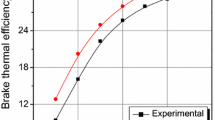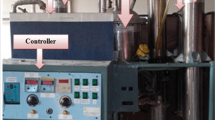Abstract
An attempt has been made to use biodiesel prepared from non-edible portion of palm oil as fuel of a conventional mono-cylinder compression ignition engine. The present experimental investigation takes into account the combined effect of using blends of diesel–palm stearin biodiesel as fuels and the compression ratio on different performance, combustion and emission characteristics of the said engine. The experiments have been carried out on a single-cylinder, direct injection diesel engine at varying compression ratio of 16:1–18:1 in four steps. It is observed that the brake thermal efficiency reduces by 7.9% when neat biodiesel is used instead of diesel. But, it increases with the increase in compression ratio for all the blends. Brake specific fuel consumption and exhaust gas temperature increase with the addition of biodiesel to diesel and also with the increase in compression ratio. Heat release rate decreases with biodiesel, and it is minimum at the rated compression ratio of 17.5:1 for all the fuels considered here. On the other hand, ignition delay is found to be more with neat diesel, and it increases with the decrease in compression ratio. Significant reductions in emissions of carbon monoxide (CO), hydrocarbon (HC) and smoke are observed with biodiesel, while the emissions of oxides of nitrogen (NOx) and carbon dioxide (CO2) increase. The decrease in compression ratio increases the emissions of CO, HC and smoke, but the emissions of NOx and CO2 decrease with the decrease in compression ratio.












Similar content being viewed by others
References
Amarnath HK, Prabhakaran P (2012) A study on the thermal performance and emissions of a variable compression ratio diesel engine fuelled with karanja biodiesel and the optimization of parameters based on experimental data. Int J Green Energy 9:841–863
Amarnath HK, Prabhakaran P, Bhat SA, Paatil R (2014) A comparative analysis of thermal performance and emission characteristics of methyl esters of karanja and jatropha oils based on a variable compression ratio diesel engine. Int J Green Energy 11:675–694
Anand K, Sharma RP, Mehta PS (2011) Experimental investigation on combustion, performance and emission characteristics of neat karanji biodiesel and its methanol blend in a diesel engine. Biomass Bioenergy 35:533–541
Babu AR, Rao GAP, Prasad TH (2015) Performance and emission characteristics of CI engine with methyl esters of palm stearin under varying compression ratios and fuel injection pressures. Int J Eng Manag Res 5:61–69
Babu AR, Rao GAP, Prasad TH (2016) Experimental investigations on a variable compression ratio (VCR) CIDI engine with a blend of methyl esters palm stearin-diesel for performance and emissions. Int J Ambient Energy. doi:10.1080/01430750.2015.1132768
Behçet R (2011) Performance and emission study of waste anchovy fish biodiesel in a diesel engine. Fuel Process Technol 92:1187–1194
Canakci M, Sayin C, Gumus M (2008) Exhaust emissions and combustion characteristics of a direct injection (DI) diesel engine fueled with methanol-diesel fuel blends at different injection timings. Energy Fuels 22:3709–3723
Datta A, Mandal BK (2016) A comprehensive review of biodiesel as an alternative fuel for compression ignition engine. Renew Sustain Energy Rev 57:799–821
Gumus MA (2010) Comprehensive experimental investigation of combustion and heat release characteristics of a biodiesel (hazelnut kernel oil methyl ester) fueled direct injection compression ignition engine. Fuel 89:2802–2814
Heywood JB (1988) Internal combustion engine fundamentals. McGraw-Hill Co, New York
Hirkude J, Padalkar AS (2014) Experimental investigation of the effect of compression ratio on performance and emissions of CI engine operated with waste fried oil methyl ester blend. Fuel Process Technol 128:367–375
Holman JP (2012) Experimental methods for engineers, 4th edn. McGraw-Hill Co, New York
Huang ZH, Lu HB, Jiang DM, Zeng K, Liu B, Zhang JQ, Wang XB (2004) Combustion characteristics and heat release analysis of a compression ignition engine operating on a diesel/methanol blend. Proc Inst Mech Eng D—J Autmob 218:1011–1024
Jindal S (2011) Experimental investigation of the effect of compression ratio and injection pressure in a direct injection diesel engine running on karanj methyl ester. Int J Sustain Energy 30:S91–S105
Jindal S, Nandwana BP, Rathore NS, Vashistha V (2010) Experimental investigation of the effect of compression ratio and injection pressure in a direct injection diesel engine running on jatropha methyl ester. Appl Therm Eng 30:442–448
Lai OM, Ghazali HM, Cho F, Chong CL (2000) Physical and textural properties of an experimental table margarine prepared from lipase-catalysed transesterified palm stearin: palm kernel olein mixture during storage. Food Chem 71:173–179
Mohanraj T, Kumar KMM (2013) Operating characteristics of a variable compression ratio engine using esterified tamanu oil. Int J Green Energy 10:285–301
Muralidharan K, Vasudevan D (2011) Performance, emission and combustion characteristics of a variable compression ratio engine using methyl esters of waste cooking oil and diesel blends. Appl Energy 88:3959–3968
Palit S, Chowdhuri AK, Mandal BK (2011) Environmental impact of using biodiesel as fuel in transportation: a review. Int J Glob Warm 3:232–256
Qi DH, Geng LM, Chen H, Bian YZH, Liu J, Ren XCH (2009) Combustion and performance evaluation of a diesel engine fueled with biodiesel produced from soybean crude oil. Renew Energy 34:2706–2713
Raheman H, Ghadge SV (2008) Performance of diesel engine with biodiesel at varying compression ratio and ignition timing. Fuel 87:2659–2666
Raheman H, Phadatare AG (2004) Diesel engine emissions and performance from blends of karanja methyl ester and diesel. Biomass Bioenergy 27:393–397
Ramalingam S, Chinnaia P, Rajendran S (2014) Influence of compression ratio on the performance and emission characteristics of annona methyl ester operated DI diesel engine. Adv Mech Eng. doi:10.1155/2014/832470
Rao GAP, Kaleemuddin S (2011) Development of variable timing fuel injection cam for effective abatement of diesel engine emissions. Appl Energy 88:2653–2662
Sahoo PF, Das LM (2009) Combustion analysis of jatropha, karanja and polanga based biodiesel as fuel in a diesel engine. Fuel 88:994–999
Sayin C (2010) Engine performance and exhaust gas emissions of methanol and ethanol–diesel blends. Fuel 89:3410–3415
Sayin C, Gumus M (2011) Impact of compression ratio and injection parameters on the performance and emissions of a DI diesel engine fueled with biodiesel-blended diesel fuel. Appl Therm Eng 31:3182–3188
Sharma A, Murugan S (2015) Potential for using a tyre pyrolysis oil-biodiesel blend in a diesel engine at different compression ratios. Energy Convers Manag 93:289–297
Sharon H, Karuppasamy K, Kumar DRS, Sundaresan A (2012) A test on DI diesel engine fueled with methyl esters of used palm oil. Renew Energy 47:160–166
Sonar D, Soni SL, Sharma D, Srivastava A, Goyal R (2015) Performance and emission characteristics of a diesel engine with varying injection pressure and fuelled with raw mahua oil (preheated and blends) and mahua oil methyl ester. Clean Technol Environ Policy 17:1499–1511
Author information
Authors and Affiliations
Corresponding author
Rights and permissions
About this article
Cite this article
Datta, A., Mandal, B.K. An experimental investigation on the performance, combustion and emission characteristics of a variable compression ratio diesel engine using diesel and palm stearin methyl ester. Clean Techn Environ Policy 19, 1297–1312 (2017). https://doi.org/10.1007/s10098-016-1328-3
Received:
Accepted:
Published:
Issue Date:
DOI: https://doi.org/10.1007/s10098-016-1328-3




